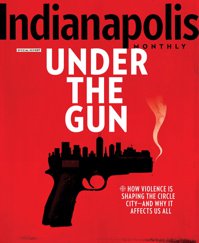
Under the Gun: Indy’s Tale of Two Cities
There are two versions of Indianapolis.
In one, gun violence is a rumor discussed at boutiques, restaurants, and cultural destinations—the type of amenities that land Indy on trendy must-visit lists and rouse civic pride. Here, a homicide goes away with a sigh and the click of the remote.
In the other version, gun violence mushrooms in pockets of poverty and despair, near empty homes on pothole-lined streets, where petty arguments are squared—but never quite settled—with spilled blood. Here, the raves are shrugged off as rumor.
Last summer, over Fourth of July weekend, the two cities faced off during a violent 24-hour period.
In the early morning of July 5, stray bullets wounded seven bystanders when two men bumped into each other on a bustling Broad Ripple sidewalk and decided to resolve their confrontation with handguns. Patrons scattered. Businesses were damaged. Streets were closed. Sixty-six IMPD officers responded to the scene.
It should come as no surprise that crime and violence thrive in the absence of hope and opportunity.
Later, in a separate incident that occurred a little after 9 o’clock that night, IMPD officers Perry Renn and Nicholas Gallico were posted in a gravel alley behind 34th Street, after responding to a call of shots fired at a nearby family barbecue. A suspect, 25-year-old Major Davis Jr., stood between them in the alley. Gallico ordered Davis to raise his hands. Davis refused. He displayed a weapon, and Renn shouted. Davis triggered an assault rifle, Renn returned fire, and Gallico went for cover. When Gallico peered from around a vehicle, he saw both Davis and Renn lying on the ground.
Renn died—the third IMPD officer to fall in the line of fire in an 18-month period. Six days after Renn was slain, thousands of people attended his funeral service inside Bankers Life Fieldhouse.
Indianapolis was already well on the way to its bloodiest year in recent memory. Yet it took having a popular neighborhood come under fire within hours of a policeman being shot to shake the city awake. While everyone seemed to agree that something needed to be done, no one could agree on the what. Finally, in October, Mayor Greg Ballard and IMPD unveiled a plan to focus on six of Marion County’s most dangerous areas, and earlier this year, the police department announced it would add 115 new officers. That’s a start. But will it be enough?
Joe Hogsett, at this writing the only declared mayoral candidate for 2015, cited the Fourth of July mayhem as the final push he needed to leave his post as U.S. Attorney for Indy’s top office. Reverend Charles Harrison, president of the anti-crime Ten Point Coalition, is also mulling a run. “Kids are no longer resolving fights and disagreements with their fists,” he said in an interview with IM last year. “They’re turning to guns, killing one another without a thought.” He said a flood of illegal guns and heroin, and a high unemployment rate in the inner city, were accelerants.
Close to 200 people died by way of the gun last year in Marion County (where the lion’s share of fatalities in the metro area occurred). The 125 firearm-related criminal homicides in 2014 were the highest total in at least a decade. Eighty-three of the victims—two-thirds—were black males. More than half were under the age of 30. The two eastside ZIP codes with the highest number of gun homicides, 46218 and 46201, had median household incomes about 40 percent lower than the county as a whole. It should come as no surprise that crime and violence thrive in the absence of hope and opportunity. Not that better-off neighborhoods are immune. Suicides by firearm attracted less attention, but they were numerous and no less tragic for loved ones of the mostly white, middle-aged victims.
While the overall death total is alarming, recordkeeping by local authorities seems insufficient. For the accompanying timeline of firearm fatalities in 2014, IM had to mine numerous sources of government and media records—no single clearinghouse existed. How can the public weigh in on policy debates when we can’t see the contours of the problem in real time? To be fair, the alarming rise in gun violence hasn’t gone unnoticed among city leaders. This past March, the mayor launched a “Your Life Matters” initiative aimed at reaching out to young men most at risk of becoming statistics.
The timeline does make one thing clear: Indianapolis does not have a gun problem or a homicide problem or a crime problem or a socioeconomic problem or a drug problem. It has an all-of-the-above problem.
See for yourself. And if you’re not moved by the stark catalog of human wreckage, consider this: Indianapolis will never be great, never be safe, as long as it remains two cities instead of one.
Indianapolis is coming off one of its deadliest years ever. Under The Gun, from our February 2015 issue, offers a grim look at the violence killing our city.





